Meet Humboldt, a magnificent lunar crater compromised by its life on the edge.
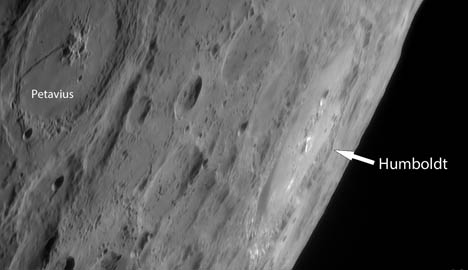
Oskari Syynimaa
I don't mean to sound grumpy. I just wish this magnificent crater lay closer to the center of the Moon. It would be an instant magnet, as magnificent as Copernicus or Clavius, but instead it's relegated to the fringe. Rarely do amateurs put the crater on their observing lists — because it sits so close to the Moon's edge, studying Humboldt's interior is like looking into a saucer almost edge-on. To see it best and least foreshortened, we must bide our time until a favorable libration tips the crater our way.
I wanted to share Humboldt with you last winter, but after doing simulations, I discovered that good evening viewing would have to wait till May or June.
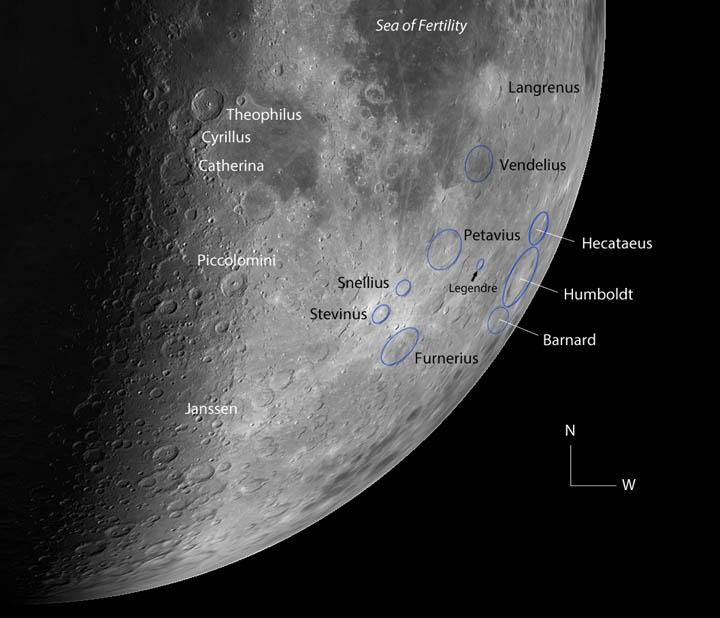
Virtual Moon Atlas / Christian Legrand & Patrick Chevalley
I like life on the limb and eagerly study craters and other features that occupy the land of "Here there be monsters." Examining the lunar circumference at high magnification, you get an "on approach" view of crater walls and mountain peaks, as if you're coming in for a landing. Many of my fellow lunatics also enjoy the challenge of ferreting out features photographed by orbiting spacecraft including Apollo. During their many lunar orbits, the astronauts got to see Humboldt and other edgy craters in their full glory. We can use their photos to help us better identify details here and in other craters nearby.
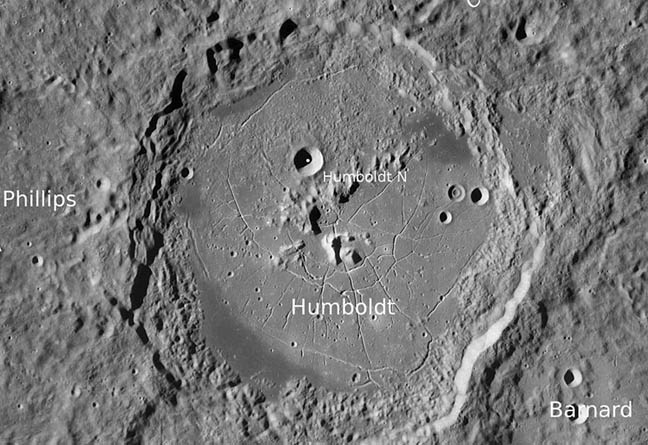
NASA / LRO
Let's see what this crater's got going for it:
- Enormity — It's 207 km (129 miles) across, or just 18 km (11 miles) smaller than Clavius, the third largest crater on the lunar nearside.
- Cool cracks — It's host to a spiderweb of radial and concentric rills from faulting and lava flows that testify to the Moon's violent and active past.
- Linear peaks — It sports a curious linear range of hills that stretch across the central floor.
- Bull's-eye crater — Can you find a more beautiful example of an interior concentric crater?
- Dark spots — Four dark mare patches nestle into areas where the crater floor meets the rim. Lava may have bubbled up through faults and pooled here during the Moon's volcanically active past.
Not that you can see all these things, but there's a surprising amount visible in 6-inch and larger telescopes. During the Moon's waxing phase this month and next, favorable librations put Humboldt's best face on view. June 28th through July 4th are ideal. And though the crater's right on the limb on July 8th, the low sunset light should make the central peaks and hill snap into view. The next good observing window opens from July 24th to August 2nd. While it only takes 50× to find Humboldt, I recommend a magnification of 200× for a good explore.
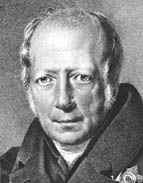
S&T / Public Domain
The crater's named for Wilhelm von Humboldt, a German statesman and brother of Alexander von Humboldt, the famous naturalist and explorer. You'll find it just inside the southeastern lunar limb, east of the prominent peaked crater Petavius — which is worth a look, too! Like Humboldt, it also has a fractured floor.
When the Moon is in a waxing crescent or waning gibbous phase, shadowy, low-angled sunlight highlights the textures of the central mountain chain, delicate rills, and the biggest interior crater, Humboldt N.
The four dark lava patches greatly resemble the smaller, pyroclastic deposits in the interior of Alphonsus and hint at volcanic fountains and lava flows in the crater's distant past. Also look for a small, rayed crater halfway between the center and the south rim, apparent when the Sun stands high over the crater, between first and last quarters.
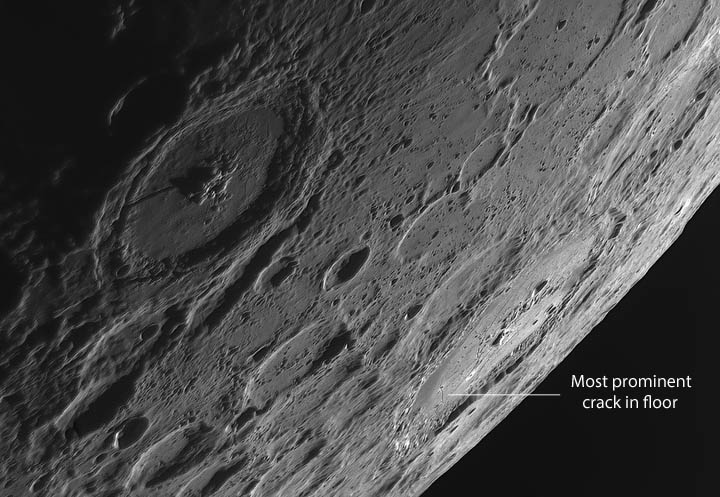
Wolfgang Paech and Franz Hofmann
I've caught hints of the rills as brighter patches around local noon but have never seen them distinctly. The easiest rill, if any might be considered such, slices approximately east-west 1/3 of the way from the southern rim to the central peak. Look for a short, dark segment in the otherwise smooth floor a day or two after sunrise or before sunset at the crater. Under the right lighting, a 10-inch should show it. So many of Humboldt's rills formed as a result of magma spreading under the floor of the crater, uplifting it, and fracturing it into sections.
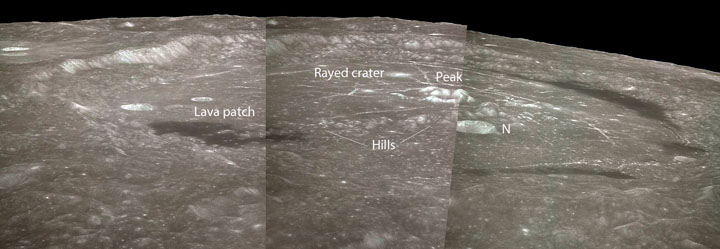
NASA / labels by author
Be sure to play your eye around the crater's circumference: Humboldt's weathered, slumped walls are apparent especially to the south, where they resemble those in Copernicus but on a grander scale.
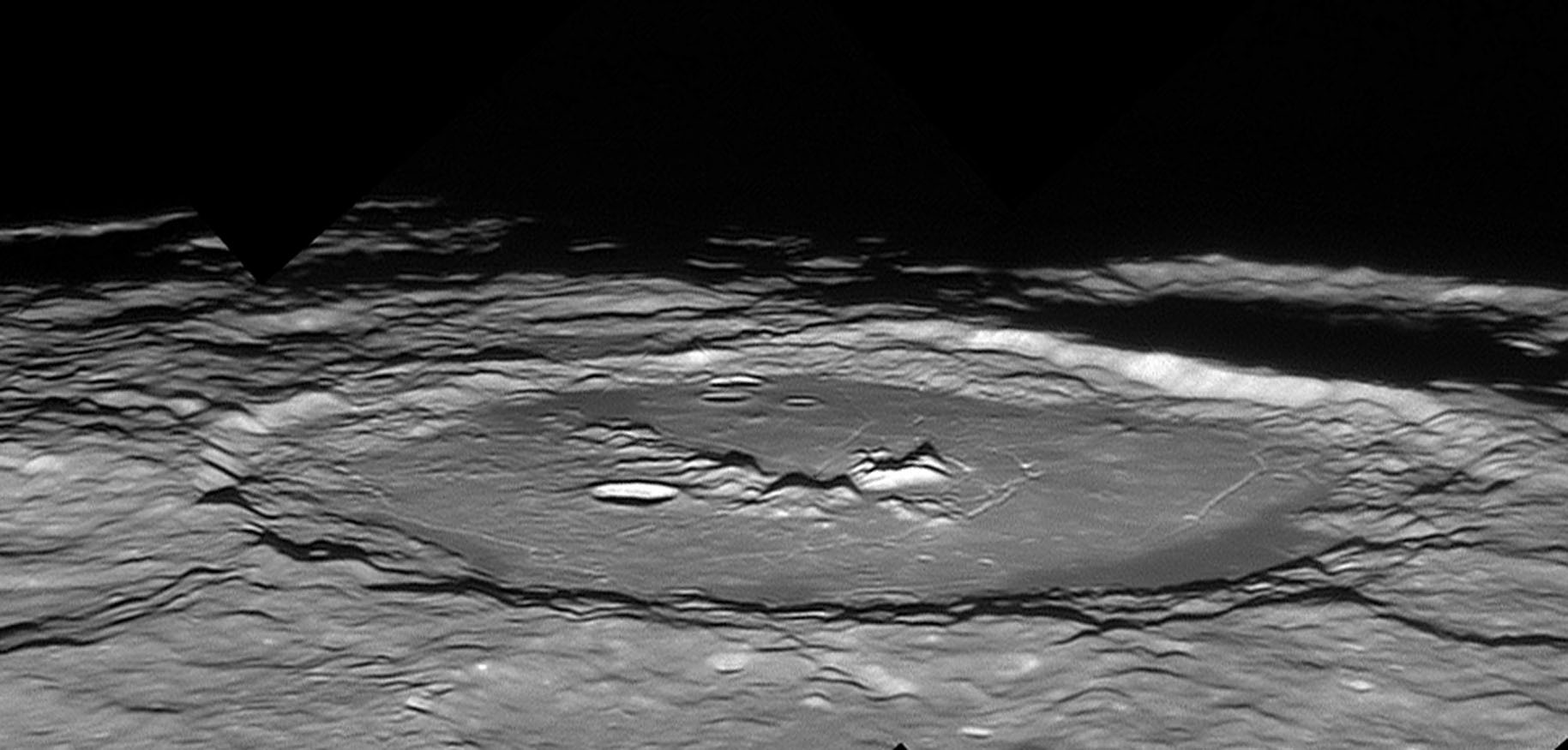
Damian Peach
Photos show what appears to be a multi-peaked central mountain that looks like a couple of closely-spaced white dots in high sunlight, as well as a range of hills trending northeast to southwest slightly north of the crater's center. The hills and the bumpy terrain to their north looks suspiciously like an impact deposit — material blasted into the crater from another impact in the region. Just a hunch.
Grab a pair of those red-blue 3D glasses and see Humboldt Crater in three dimensions.
I invite you to explore Humboldt at every phase of the Moon to fully appreciate its many facets. Don't let its shyness stop you from being a repeat visitor.
 8
8








Comments
Anthony Barreiro
June 29, 2017 at 5:49 pm
Huh. I always assumed Humboldt Crater was named after Alexander von Humboldt. I guess he's got enough terrestrial features named after him, so Wilhelm gets a lunar crater.
By the way, I think there is one small error. The paragraph:
"When the Moon is in a waxing or waning crescent phase, shadowy, low-angled sunlight highlights the textures of the central mountain chain, delicate rills, and the biggest interior crater, Humboldt N."
should read, "When the Moon is in a waxing crescent or waning gibbous phase ... ".
We should get some clear weather this weekend, and my astronomy club is holding a public star party Saturday evening, so I'll have a look!
You must be logged in to post a comment.
Bob KingPost Author
June 29, 2017 at 6:05 pm
Anthony,
Absolutely true! Thank you for pointing out the error. That's exactly what I meant, but it came out wrong. Good luck in exploring the crater!
You must be logged in to post a comment.
June 30, 2017 at 6:04 pm
I would love to see a book of "overhead photos" from the LRO. It would be fun to look at the photo and compare that to what I see, especially when I'm viewing a limb resident that doesn't show up very often, and only gives me a sideways glance when it does.
You must be logged in to post a comment.
Bob KingPost Author
June 30, 2017 at 6:47 pm
Hi Doctor V,
Sideways glance - nice! Have you checked out the LROC archive site -- http://www.lroc.asu.edu/archive
You must be logged in to post a comment.
Mike McCabe
July 1, 2017 at 10:16 am
Thanks Bob, this article got me out to have a look at Humboldt the other night. It was a tough observe at 29% waxing crescent, but I was able to see the central peaks chain and the nearest lava flow on the floor of the crater.
While I was there I also happened to notice something else I'd never seen before, and I documented it here on the bulletin board of one of my astronomy clubs; http://www.assne.org/board/viewtopic.php?f=98&p=45962&sid=7cecfd2c6914f10f97fbffb6550379da#p45962 Please have a look and tell me if you've ever seen or heard of it before.
@ Doctor V; Chuck Woods latest moon atlas uses all LRO images, although I'm not sure if they're all overhead. It is a nice atlas though; https://www.amazon.com/21st-Century-Atlas-Moon-Charles/dp/1938228804
You must be logged in to post a comment.
Bob KingPost Author
July 1, 2017 at 10:45 am
Hi Mike,
Thanks for sharing your observation of Humboldt. Regarding the lava patches, I think if you look now (around first quarter) under a much higher sun (for Humboldt) you'll see all four with ease. That is a most interesting "X" you've found. I've not noticed it before. After studying it up close on the ACT-REACT LROC map, the vertical axis appears to be a happenstance alignment of crater walls but who knows, possibly an ancient, eroded fault line. The more horizontal axis is more difficult to fathom.
You must be logged in to post a comment.
Mike McCabe
July 4, 2017 at 5:14 pm
Bob, you were right. I got out last night (about 78% waxing gibbous) and was able to see all four lava flows with ease The high sun made all the difference.
You must be logged in to post a comment.
Bob KingPost Author
July 4, 2017 at 8:35 pm
Hi Mike,
Wonderful to hear it! I'm hoping to catch a sunset on Humboldt the day after full.
You must be logged in to post a comment.
You must be logged in to post a comment.